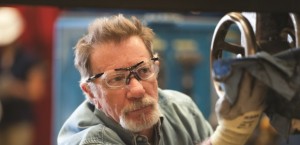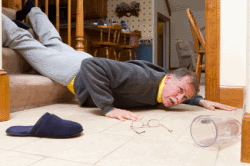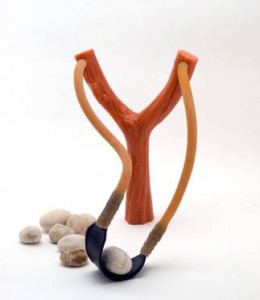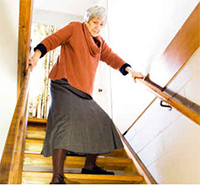Category: Safety
Safety at home: Falls
Falls are the second leading type of unintentional home-related injury deaths. Falls occur most commonly in:
- Doorways
- Ramps
- Ladders
- Stairs
- Crowded areas
- Areas with uneven surfaces
Among older adults, falls can result in serious injury and an increased risk of fatality.
Fall Proofing Your Home
You can prevent falls by “fall-proofing your home.” Take simple steps such as storing objects within easy reach and keeping electrical cords out of the way. If possible, add handrails to stairs to keep your family safe and use non-skid bath mats to prevent falls in the bathroom. Teach children to pick up their toys when done playing and keep your own home clean by wiping up spills immediately. These are just a few of the ways you can keep the ones you love from slipping and tripping.
Older Adult Falls
Adults 55 and older are more prone to becoming victims of falls. You can prevent older adult falls by improving balance through exercise and visiting the doctor annually. Other precautions include wearing fitted shoes, knowing the side effects of medications and storing those meds in a well-lit area.
How will a healthy work environment benefit my bottom line?
 Research shows that healthy people working in a healthy environment are key to business success. That’s because a healthy workplace improves productivity and reduces employers’ costs.
Research shows that healthy people working in a healthy environment are key to business success. That’s because a healthy workplace improves productivity and reduces employers’ costs.
A healthy workplace will:
- Improve employee health outcomes
- Make it easier to attract and retain qualified employees
- Lower absenteeism
- Reduce health benefit costs
- Enhance morale
- Reduce risk of injury
- Improve job performance
via What Makes a Healthy Work Environment? – Healthy Environments.
Materials Handling: Heavy Lifting
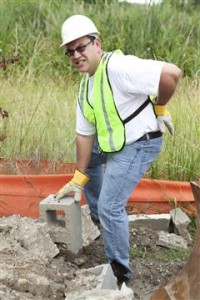 Lifting heavy items is one of the leading causes of injury in the workplace. In 2001, the Bureau of Labor Statistics reported that over 36 percent of injuries involving missed workdays were the result of shoulder and back injuries. Overexertion and cumulative trauma were the biggest factors in these injuries.
Lifting heavy items is one of the leading causes of injury in the workplace. In 2001, the Bureau of Labor Statistics reported that over 36 percent of injuries involving missed workdays were the result of shoulder and back injuries. Overexertion and cumulative trauma were the biggest factors in these injuries.
When employees use smart lifting practices and work in their “power zone,” they are less likely to suffer from back sprains, muscle pulls, wrist injuries, elbow injuries, spinal injuries, and other injuries caused by lifting heavy objects.
- Weight of Objects
- Awkward Postures
- High-Frequency and Long-Duration Lifting
- Inadequate Handholds
- Environmental Factors
via Ergonomics eTool: Solutions for Electrical Contractors – Materials Handling: Heavy Lifting.
Texting and Driving Prevention.
 Fact # 1 – Five seconds is the average time your eyes are off the road while texting. When traveling at 55mph, that’s enough time to cover the length of a football field.
Fact # 1 – Five seconds is the average time your eyes are off the road while texting. When traveling at 55mph, that’s enough time to cover the length of a football field.
Fact # 2 – Reaching for a phone, dialing, texting and other uses of portable devices increased the risk of getting into a crash by three times.
Fact # 3 – 11% of all drivers under 20 involved in fatal crashes were reported as distracted. This age group has the largest proportion of drivers who were distracted.
Health Care Workers
 Healthcare is the fastest-growing sector of the U.S. economy, employing over 18 million workers. Women represent nearly 80% of the healthcare work force. Health care workers face a wide range of hazards on the job, including needlestick injuries, back injuries, latex allergy, violence, and stress. Although it is possible to prevent or reduce healthcare worker exposure to these hazards, healthcare workers continue to experience injuries and illnesses in the workplace. Cases of nonfatal occupational injury and illness among to healthcare workers are among the highest of any industry sector.
Healthcare is the fastest-growing sector of the U.S. economy, employing over 18 million workers. Women represent nearly 80% of the healthcare work force. Health care workers face a wide range of hazards on the job, including needlestick injuries, back injuries, latex allergy, violence, and stress. Although it is possible to prevent or reduce healthcare worker exposure to these hazards, healthcare workers continue to experience injuries and illnesses in the workplace. Cases of nonfatal occupational injury and illness among to healthcare workers are among the highest of any industry sector.
via CDC – Health Care Workers – NIOSH Workplace Safety and Health Topic.
How Can I Be Sure Toys are Safe?
- Choose carefully when shopping for toys. Look for toys that are well made and appropriate for your child’s age.
- Watch out for toys that have sharp edges, small parts or sharp points.
- Young children pull, prod and twist toys. Look for toys with tightly secured parts.
- Look for safety information on the toy or label such as “Not recommended for children under 3 years of age,” or “non-toxic” on toys likely to end up in little mouths. Look for “washable/hygienic materials” on stuffed toys and dolls.
- Avoid marbles, balls, games with balls and other toys that have parts smaller than 1 3/4 inches in diameter or smaller than 2 inches long. These products can choke young children if swallowed.
- Keep toys meant for older children away from babies and toddlers.
via Child Safety: Keeping Your Home Safe for Your Baby — FamilyDoctor.org.
Prevent Falls In and Outside of Your Home
Falls are the second leading type of unintentional home-related injury deaths. Falls occur most commonly in:
- Doorways
- Ramps
- Ladders
- Stairs
- Crowded areas
- Areas with uneven surfaces
Among older adults, falls can result in serious injury and an increased risk of fatality.
Fall Proofing Your Home – You can prevent falls by “fall-proofing your home.” Take simple steps such as storing objects within easy reach and keeping electrical cords out of the way. If possible, add handrails to stairs to keep your family safe and use non-skid bath mats to prevent falls in the bathroom. Teach children to pick up their toys when done playing and keep your own home clean by wiping up spills immediately. These are just a few of the ways you can keep the ones you love from slipping and tripping.
Older Adult Falls – Adults 55 and older are more prone to becoming victims of falls. You can prevent older adult falls by improving balance through exercise and visiting the doctor annually. Other precautions include wearing fitted shoes, knowing the side effects of medications and storing those meds in a well-lit area.
The Human Cost of Motor Vehicle Accidents
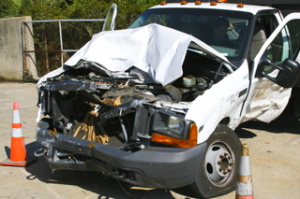 Drivers take a lot of risks on our roads today – with people speeding, driving impaired, massive traffic congestion and the prevalent use of mobile phones all has led to a high probability of accidents.
Drivers take a lot of risks on our roads today – with people speeding, driving impaired, massive traffic congestion and the prevalent use of mobile phones all has led to a high probability of accidents.
Employees injured in a motor vehicle accident can have a negative boomerang effect to a company by incurring costs such as lost production, workers compensation, replacement costs such as new staff and equipment, insurance premiums/increases and a potential burden of civil lawsuits. But the huge financial burden and human cost of road crashes goes far beyond your workplace. In 2013 the National Safety Council documented the estimated cost of motor vehicle deaths was $267.5 billion.
Thanksgiving Safety
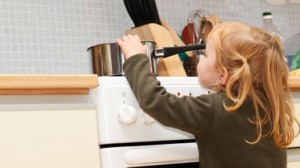 The kitchen is the heart of the home, especially at Thanksgiving. Kids love to be involved in holiday preparations. Safety in the kitchen is important, especially on Thanksgiving Day when there is a lot of activity and people at home.
The kitchen is the heart of the home, especially at Thanksgiving. Kids love to be involved in holiday preparations. Safety in the kitchen is important, especially on Thanksgiving Day when there is a lot of activity and people at home.
Safety tips
- Stay in the kitchen when you are cooking on the stovetop so you can keep an eye on the food.
- Stay in the home when cooking your turkey and check on it frequently.
- Keep children away from the stove. The stove will be hot and kids should stay 3 feet away.
- Make sure kids stay away from hot food and liquids. The steam or splash from vegetables, gravy or coffee could cause serious burns.
- Keep the floor clear so you don’t trip over kids, toys, pocketbooks or bags.
- Keep knives out of the reach of children.
- Be sure electric cords from an electric knife, coffee maker, plate warmer or mixer are not dangling off the counter within easy reach of a child.
- Keep matches and utility lighters out of the reach of children — up high in a locked cabinet.
- Never leave children alone in room with a lit a candle.
- Make sure your smoke alarms are working. Test them by pushing the test button.
via Thanksgiving safety.

